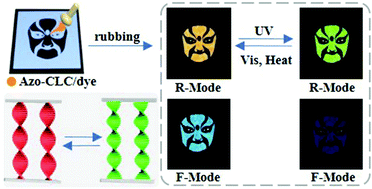Fabrication of multicolored patterns based on dye-doped cholesteric liquid crystals†
Abstract
We developed a type of dye-doped cholesteric liquid crystal, which were used for fluorescence enhancement and dual-mode multicolor patterns. We added dye molecules (BBOT, coumarin 6 (C6) and rhodamine B (RhB)) to liquid crystals, and cholesteric liquid crystals (CLC) exhibited selective reflection characteristics. When the reflection wavelength overlaps with the peak of the fluorescent dye, the luminescence intensity of the dye molecules could be adjusted. We used two methods to adjust the reflection wavelength of the cholesteric liquid crystals by changing the content of chiral additives and the isomerization degree of azo molecules. We used the screen printing and stencil printing methods to combine liquid crystal particles containing different fluorescent colors to prepare multicolor patterns. Moreover, the photoisomerization characteristics of the azo molecules were also used to achieve brilliant firework-like images upon exposure to ultraviolet and visible light. In addition, we also realized a face-changing stunt with facial makeup during a performance in the Sichuan Opera, a traditional Chinese folk art. We made use of the difference between reflection color and luminescence intensity upon light irradiation to present orange, green, blue and dark-blue facial effects.



 Please wait while we load your content...
Please wait while we load your content...